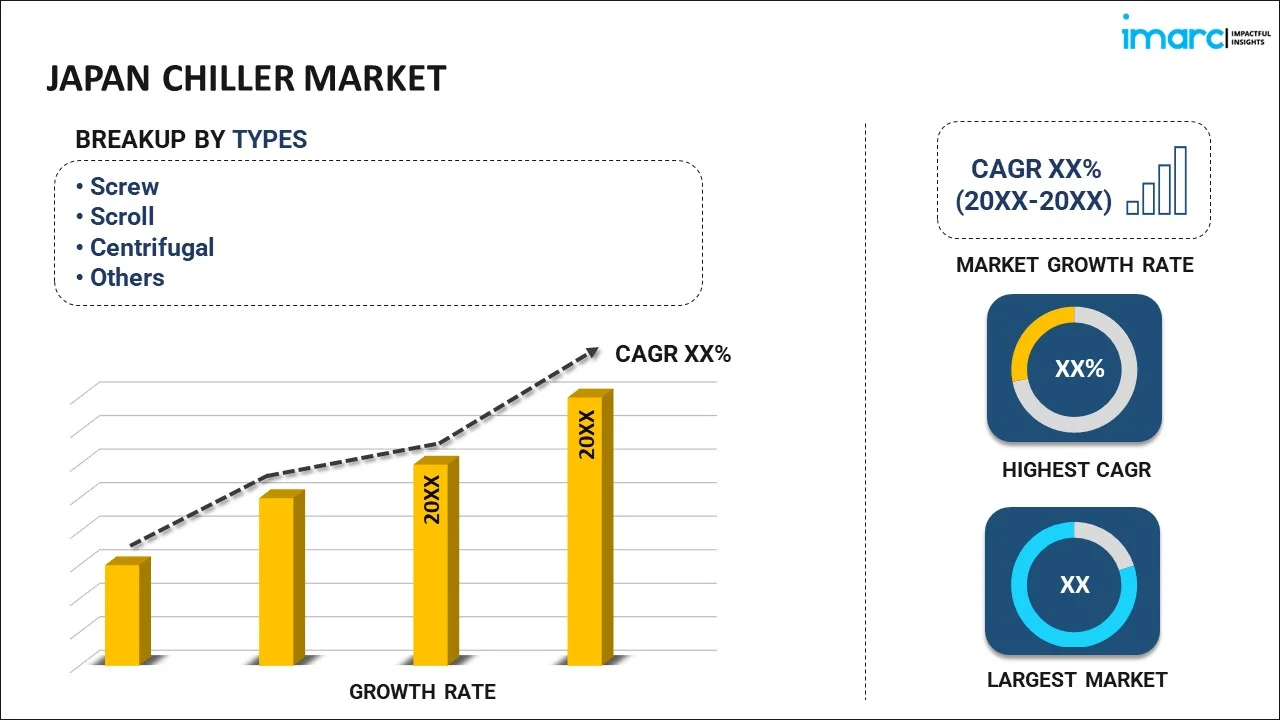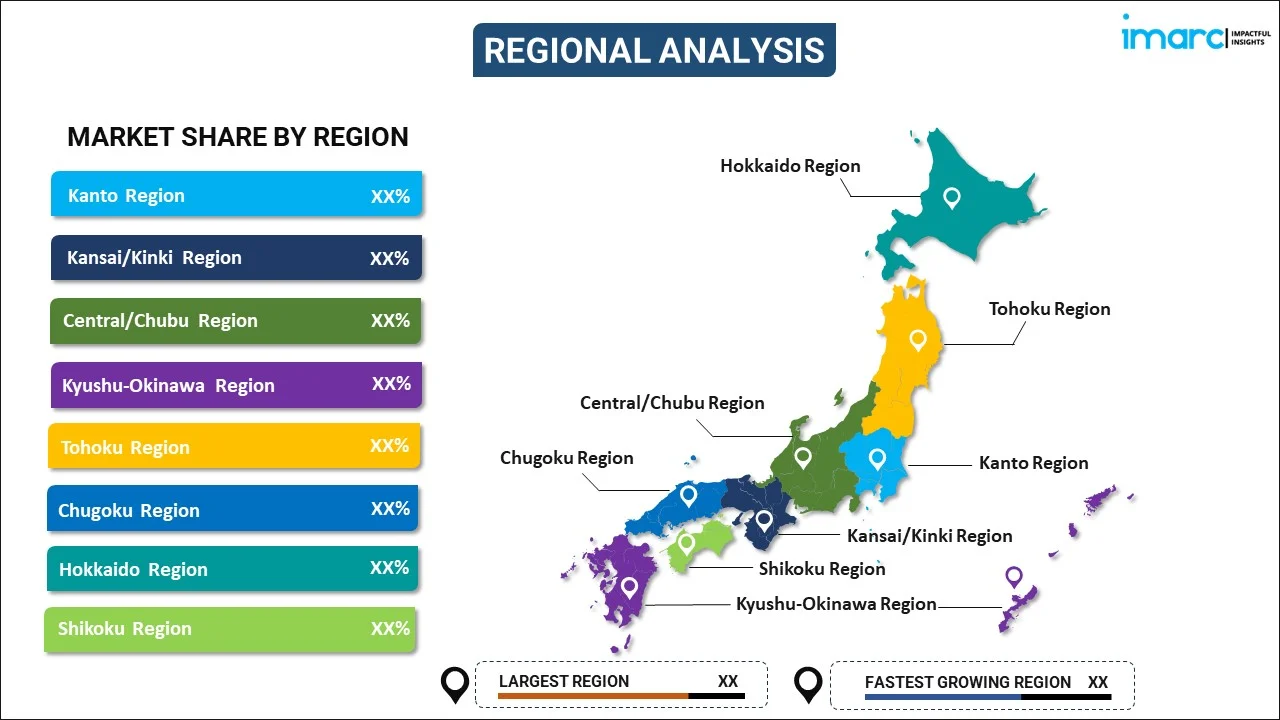
Japan Chiller Market Report by Report by Type (Screw, Scroll, Centrifugal, and Others), Product Type (Air Cooled, Water Cooled), Power Range (Less Than 50 kW, 50-200 kW, More Than 200 kW), End Use Industry (Food and Beverage, Plastic and Rubber, Chemicals and Petrochemicals, Pharmaceuticals, and Others), and Region 2025-2033
Market Overview:
Japan chiller market size reached USD 656.0 Million in 2024. Looking forward, IMARC Group expects the market to reach USD 906.0 Million by 2033, exhibiting a growth rate (CAGR) of 3.6% during 2025-2033. The expanding industries, particularly in sectors like pharmaceuticals, food processing, and data centers, which require reliable cooling systems to maintain optimal operating conditions, is primarily driving the market.
|
Report Attribute
|
Key Statistics
|
|---|---|
|
Base Year
|
2024 |
|
Forecast Years
|
2025-2033
|
|
Historical Years
|
2019-2024
|
| Market Size in 2024 | USD 656.0 Million |
| Market Forecast in 2033 | USD 906.0 Million |
| Market Growth Rate (2025-2033) | 3.6% |
A chiller is a mechanical device used in various industrial and commercial applications to cool fluids or air by removing heat. It plays a crucial role in maintaining temperature control and comfort in buildings, manufacturing processes, and other systems. Chillers work on the principle of refrigeration, using a refrigerant to absorb heat from a fluid, typically water or a mixture of water and glycol. The heat-laden refrigerant is then circulated to an evaporator, where it releases the heat, causing the fluid to cool down. The cooled fluid is then pumped to the desired location, such as air handling units in HVAC systems or industrial equipment, to regulate temperatures. Chillers come in various types, including air-cooled and water-cooled, and they can range in size from small units for residential use to large, industrial-scale systems. They are essential for maintaining the temperature requirements in data centers, food processing, pharmaceuticals, and countless other applications, making them a vital component of modern infrastructure and manufacturing processes.
Japan Chiller Market Trends:
The chiller market in Japan is experiencing robust growth due to several key drivers. Firstly, the increasing demand for air conditioning and refrigeration in commercial and industrial sectors has propelled the chiller market forward. Consequently, this heightened demand is a result of rising temperatures and the need for efficient cooling solutions, thereby boosting the adoption of chillers. Furthermore, stringent environmental regulations play a pivotal role in the chiller market's expansion. Governments in Japan are implementing strict regulations to curb greenhouse gas emissions and promote energy-efficient technologies. Consequently, this has driven the chiller industry to develop eco-friendly, energy-efficient models. Consequently, these environmentally conscious initiatives have not only fueled innovation but also influenced consumer preferences. Moreover, technological advancements, which have led to the development of smart and connected chillers that offer enhanced control and monitoring capabilities to improve operational efficiency and reduce energy consumption, are expected to drive the chiller market in Japan during the forecast period.
Japan Chiller Market Segmentation:
IMARC Group provides an analysis of the key trends in each segment of the market, along with forecasts at the country level for 2025-2033. Our report has categorized the market based on type, product type, power range, and end use industry.
Type Insights:

- Screw
- Scroll
- Centrifugal
- Others
The report has provided a detailed breakup and analysis of the market based on the type. This includes screw, scroll, centrifugal, and others.
Product Type Insights:
- Air Cooled
- Water Cooled
A detailed breakup and analysis of the market based on the product type have also been provided in the report. This includes air cooled and water cooled.
Power Range Insights:
- Less Than 50 kW
- 50-200 kW
- More Than 200 kW
The report has provided a detailed breakup and analysis of the market based on the power range. This includes less than 50 kw, and 50-200 kw, and more than 200 kw.
End Use Industry Insights:
- Food and Beverage
- Plastic and Rubber
- Chemicals and Petrochemicals
- Pharmaceuticals
- Others
A detailed breakup and analysis of the market based on the end use industry have also been provided in the report. This includes food and beverage, plastic and rubber, chemicals and petrochemicals, pharmaceuticals, and others.
Regional Insights:

- Kanto Region
- Kansai/Kinki Region
- Central/ Chubu Region
- Kyushu-Okinawa Region
- Tohoku Region
- Chugoku Region
- Hokkaido Region
- Shikoku Region
The report has also provided a comprehensive analysis of all the major regional markets, which include Kanto Region, Kansai/Kinki Region, Central/ Chubu Region, Kyushu-Okinawa Region, Tohoku Region, Chugoku Region, Hokkaido Region, and Shikoku Region.
Competitive Landscape:
The market research report has also provided a comprehensive analysis of the competitive landscape. Competitive analysis such as market structure, key player positioning, top winning strategies, competitive dashboard, and company evaluation quadrant has been covered in the report. Also, detailed profiles of all major companies have been provided.
Japan Chiller Market Report Coverage:
| Report Features | Details |
|---|---|
| Base Year of the Analysis | 2024 |
| Historical Period | 2019-2024 |
| Forecast Period | 2025-2033 |
| Units | Million USD |
| Scope of the Report | Exploration of Historical and Forecast Trends, Industry Catalysts and Challenges, Segment-Wise Historical and Predictive Market Assessment:
|
| Types Covered | Screw, Scroll, Centrifugal, Others |
| Product Types Covered | Air Cooled, Water Cooled |
| Power Ranges Covered | Less Than 50 kW, 50-200 kW, More Than 200 kW |
| End Use Industries Covered | Food and Beverage, Plastic and Rubber, Chemicals and Petrochemicals, Pharmaceuticals, Others |
| Regions Covered | Kanto Region, Kansai/Kinki Region, Central/ Chubu Region, Kyushu-Okinawa Region, Tohoku Region, Chugoku Region, Hokkaido Region, Shikoku Region |
| Customization Scope | 10% Free Customization |
| Post-Sale Analyst Support | 10-12 Weeks |
| Delivery Format | PDF and Excel through Email (We can also provide the editable version of the report in PPT/Word format on special request) |
Key Questions Answered in This Report:
- How has the Japan chiller market performed so far and how will it perform in the coming years?
- What has been the impact of COVID-19 on the Japan chiller market?
- What is the breakup of the Japan chiller market on the basis of type?
- What is the breakup of the Japan chiller market on the basis of product type?
- What is the breakup of the Japan chiller market on the basis of power range?
- What is the breakup of the Japan chiller market on the basis of end use industry?
- What are the various stages in the value chain of the Japan chiller market?
- What are the key driving factors and challenges in the Japan chiller?
- What is the structure of the Japan chiller market and who are the key players?
- What is the degree of competition in the Japan chiller market?
Key Benefits for Stakeholders:
- IMARC’s industry report offers a comprehensive quantitative analysis of various market segments, historical and current market trends, market forecasts, and dynamics of the Japan chiller market from 2019-2033.
- The research report provides the latest information on the market drivers, challenges, and opportunities in the Japan chiller market.
- Porter's five forces analysis assist stakeholders in assessing the impact of new entrants, competitive rivalry, supplier power, buyer power, and the threat of substitution. It helps stakeholders to analyze the level of competition within the Japan chiller industry and its attractiveness.
- Competitive landscape allows stakeholders to understand their competitive environment and provides an insight into the current positions of key players in the market.
Need more help?
- Speak to our experienced analysts for insights on the current market scenarios.
- Include additional segments and countries to customize the report as per your requirement.
- Gain an unparalleled competitive advantage in your domain by understanding how to utilize the report and positively impacting your operations and revenue.
- For further assistance, please connect with our analysts.
 Inquire Before Buying
Inquire Before Buying
 Speak to an Analyst
Speak to an Analyst
 Request Brochure
Request Brochure
 Request Customization
Request Customization




.webp)




.webp)












